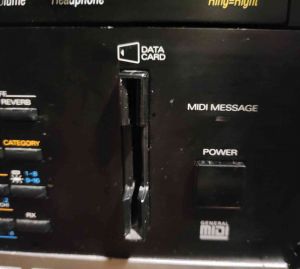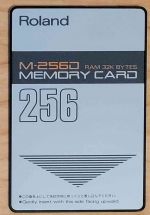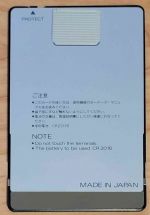Roland M series Data cards
The Roland M-series data cards are a line of proprietary writable RAM cards produced by Roland intended to be used to expand the internal memory on older Roland devices that sport a "DATA Card" or "Memory Card" slot. The series consists of multiple lettered and size variants made with different Roland synthesizers in mind. These cards are powered by a CR-2016 battery.

The cards have a lever on the top of the card (labelled "PROTECT" with an arrow on the back) that protects data from being accidentally overwritten. It must be flipped off to directly interface and write to the card. The number on each card denotes the amount of writable memory you are working with (128K bytes, 256K bytes, 512K bytes), and the letter (M-256D, M-256D, etc.) denotes the generation/revision of the card. To use a Roland M series with a device , they must undergo a specific procedure on a synthesizer to properly format them for it, and the data on those cards can only be read by the model you formatted to. For more information how this process goes, it varies on the device you are using, which you should consult the owner's manual of the device in question.
Synthesizer Compatibility
Please be sure to check the model of memory card you have closely. This list documents all compatible synthesizers and what data it can hold.
Roland M-128D
- Roland TR-626
- 96 Rhythm Patterns, 12 Tracks, 2 Drum Voice settings[1]
- Roland D-110
- 32 Patches, 128 Timbres, 32 Tones, Rhythm Setup[2]
Roland M-256D
Works on units that specified a Roland M-128D. Also may work on units that specify an M-256E.

- Roland D-50/D-550
- Roland D-110
- 64 Patches, 128 Timbres, 64 Tones, Rhythm Setup[2]
- Roland D-10/D-20
- Roland D-5
- 128 Patches, 128 Timbres, 64 Tones, Rhythm Setup[8]
- Roland JV-80/JV-880/JV-90[9][10]
- Roland E-20
- 3 Songs, 8 User Programs[13]
- Roland E-30
- 3 Songs, 48 User Programs[14]
- Roland JD-990[15]
- System Setup, 16 Performances, 64 Patches, 1 Rhythm Set[16]
Roland M-256E
M-256E is backwards compatible with synths that took M-128D/M-256D cards.
- Roland U-20
- 1 Setup, 64 Keyboard Patches, 8 Chord Sets, 64 Sound Patches, 128 Timbres, 4 Rhythm Sets[17]
- Roland D-70
- 64 Performances, 128 Patches, 128 Tones, 10 User Sets, Rhythm Setup, System Setup[18]
- Roland JV-1080/JV-2080
Roland M-512E
The M-512E also is backwards compatible with synths that originally specified an M-128D or M-256D/E card but will not read more than the capacity of those cards, even with the increased memory of the M-512E.
- Roland JV-1080/JV-2080[21]
- 32 Performances, 128 Patches, 2 Rhythm Sets [19]
References
- ↑ Roland TR-626 Owner's Manual, pg. 64
- ↑ 2.0 2.1 Roland D-110 Owner's Manual, pg. 84
- ↑ Roland D-50 Owner's Manual, pg. 65
- ↑ Roland D-550 Owner's Manual, pg. 103
- ↑ Roland D-20 Owner's Manual, pg. 35
- ↑ Roland D-10 Owner's Manual, pg. 36
- ↑ "The M-128 cannot be used for the D-10 or D-20." - Roland D-110 Owner's Manual, pg. 109
- ↑ Roland D-5 Owner's Manual, pg. 142
- ↑ JV-880: Using a RAM Card to Save and Load Settings - Roland Knowledge Base
- ↑ JV-80, JV-90: Using a RAM Card to Save and Load Settings - Roland Knowledge Base
- ↑ Roland JV-80's Owner's Manual, pg. 209
- ↑ Roland JV-90 Owner's Manual, pg. 154
- ↑ Roland E-20 Owner's Manual, pg.59
- ↑ Roland E-30 Owner's Manual, pg. 88
- ↑ JD-990: Using a RAM Card to Save and Load Settings - Roland Knowledge Base
- ↑ Roland JD-990 Owner's Manual, Chapter 8: Appendix, pg. 65
- ↑ Roland U-20 Owner's Manual, pg. 193
- ↑ Roland D-70 Owner's Manual, pg. 213
- ↑ 19.0 19.1 Roland JV-2080 Owner's Manual, Page 58
- ↑ "However, the amount of data that can be contained in an M-256E DATA Card is 64 Patches, 16 Performances, and one Rhythm set." - Roland JV-1080 Owner's Manual, pg. 73
- ↑ Roland JV-1080 Owner's Manual, pg. 164